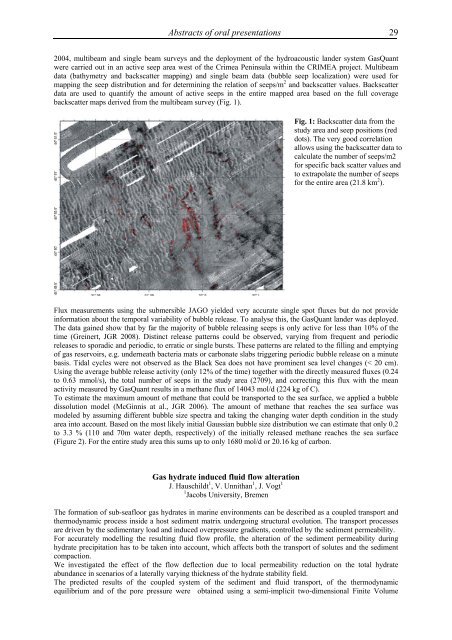Ninth international conference on - Marum
Ninth international conference on - Marum
Ninth international conference on - Marum
Create successful ePaper yourself
Turn your PDF publications into a flip-book with our unique Google optimized e-Paper software.
Abstracts of oral presentati<strong>on</strong>s 29<br />
2004, multibeam and single beam surveys and the deployment of the hydroacoustic lander system GasQuant<br />
were carried out in an active seep area west of the Crimea Peninsula within the CRIMEA project. Multibeam<br />
data (bathymetry and backscatter mapping) and single beam data (bubble seep localizati<strong>on</strong>) were used for<br />
mapping the seep distributi<strong>on</strong> and for determining the relati<strong>on</strong> of seeps/m 2 and backscatter values. Backscatter<br />
data are used to quantify the amount of active seeps in the entire mapped area based <strong>on</strong> the full coverage<br />
backscatter maps derived from the multibeam survey (Fig. 1).<br />
Fig. 1: Backscatter data from the<br />
study area and seep positi<strong>on</strong>s (red<br />
dots). The very good correlati<strong>on</strong><br />
allows using the backscatter data to<br />
calculate the number of seeps/m2<br />
for specific back scatter values and<br />
to extrapolate the number of seeps<br />
for the entire area (21.8 km 2 ).<br />
Flux measurements using the submersible JAGO yielded very accurate single spot fluxes but do not provide<br />
informati<strong>on</strong> about the temporal variability of bubble release. To analyse this, the GasQuant lander was deployed.<br />
The data gained show that by far the majority of bubble releasing seeps is <strong>on</strong>ly active for less than 10% of the<br />
time (Greinert, JGR 2008). Distinct release patterns could be observed, varying from frequent and periodic<br />
releases to sporadic and periodic, to erratic or single bursts. These patterns are related to the filling and emptying<br />
of gas reservoirs, e.g. underneath bacteria mats or carb<strong>on</strong>ate slabs triggering periodic bubble release <strong>on</strong> a minute<br />
basis. Tidal cycles were not observed as the Black Sea does not have prominent sea level changes (< 20 cm).<br />
Using the average bubble release activity (<strong>on</strong>ly 12% of the time) together with the directly measured fluxes (0.24<br />
to 0.63 mmol/s), the total number of seeps in the study area (2709), and correcting this flux with the mean<br />
activity measured by GasQuant results in a methane flux of 14043 mol/d (224 kg of C).<br />
To estimate the maximum amount of methane that could be transported to the sea surface, we applied a bubble<br />
dissoluti<strong>on</strong> model (McGinnis at al., JGR 2006). The amount of methane that reaches the sea surface was<br />
modeled by assuming different bubble size spectra and taking the changing water depth c<strong>on</strong>diti<strong>on</strong> in the study<br />
area into account. Based <strong>on</strong> the most likely initial Gaussian bubble size distributi<strong>on</strong> we can estimate that <strong>on</strong>ly 0.2<br />
to 3.3 % (110 and 70m water depth, respectively) of the initially released methane reaches the sea surface<br />
(Figure 2). For the entire study area this sums up to <strong>on</strong>ly 1680 mol/d or 20.16 kg of carb<strong>on</strong>.<br />
Gas hydrate induced fluid flow alterati<strong>on</strong><br />
J. Hauschildt 1 , V. Unnithan 1 , J. Vogt 1<br />
1 Jacobs University, Bremen<br />
The formati<strong>on</strong> of sub-seafloor gas hydrates in marine envir<strong>on</strong>ments can be described as a coupled transport and<br />
thermodynamic process inside a host sediment matrix undergoing structural evoluti<strong>on</strong>. The transport processes<br />
are driven by the sedimentary load and induced overpressure gradients, c<strong>on</strong>trolled by the sediment permeability.<br />
For accurately modelling the resulting fluid flow profile, the alterati<strong>on</strong> of the sediment permeability during<br />
hydrate precipitati<strong>on</strong> has to be taken into account, which affects both the transport of solutes and the sediment<br />
compacti<strong>on</strong>.<br />
We investigated the effect of the flow deflecti<strong>on</strong> due to local permeability reducti<strong>on</strong> <strong>on</strong> the total hydrate<br />
abundance in scenarios of a laterally varying thickness of the hydrate stability field.<br />
The predicted results of the coupled system of the sediment and fluid transport, of the thermodynamic<br />
equilibrium and of the pore pressure were obtained using a semi-implicit two-dimensi<strong>on</strong>al Finite Volume














